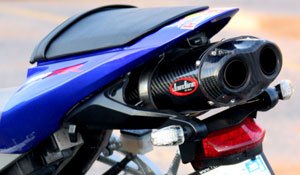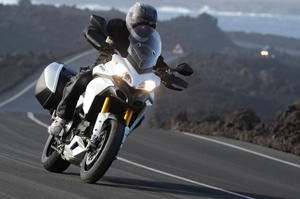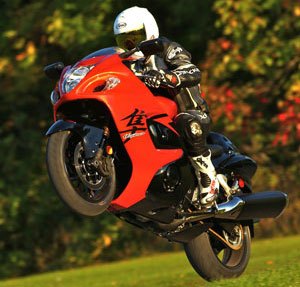We’ve already managed to cover Liability, Uninsured Motorist, and Comprehensive and Collision coverage. All these things are common with all insurers. For this article I will cover things you may not know can be covered or have never had explained by your agent, broker or underwriter. Companies that have recreational products divisions often offer extras at little or no charge at all. Accessories coverage is a great example. Most companies will offer $3000 to $5000 worth of accessories coverage at no extra cost. You have to ask your agent what the accessories coverage freebee is. What does it cover? Bags, screens, chrome, exhaust, your fuel-injection upgrade, seats, custom paint - name it and chances are it can qualify. This includes suspension upgrades.
What it doesn’t cover is the labor for installation? Why? Because you really don’t need all that stuff- you just want that stuff. And there are limits to the total accessories. Usually, it has to be less than the NADA retail value of your bike. When you exceed your freebee, coverage of the additional accessories will cost additional money. It’s not usually that expensive, but the percentage varies company to company.
 If you do not declare your accessories and have a total loss, you will only be paid for your stock bike. There are exceptions, but it comes at a price. Foremost insurance will automatically move your bike from its designated segment into a custom bike segment if the accessories exceed $15,000. Two reasons: First, you were crazy enough to spend the money in the first place. And, second, to cover constructed bikes. You bike builders know what I’m talking about.
If you do not declare your accessories and have a total loss, you will only be paid for your stock bike. There are exceptions, but it comes at a price. Foremost insurance will automatically move your bike from its designated segment into a custom bike segment if the accessories exceed $15,000. Two reasons: First, you were crazy enough to spend the money in the first place. And, second, to cover constructed bikes. You bike builders know what I’m talking about.
Performance upgrades (going into the motor, turbo or superchargers) are allowed by some companies. The same labor-not-included rule applies, but you really should declare the upgrades. If you don’t declare it, your motor will be considered “stock” and returned to that state if your motor is damaged. Transmission work applies, as well. If you purchase a slipper clutch then make sure you add it to the total of the accessories coverage with the parts cost of the motor upgrades. If you bought a Baker 6-speed for your Harley, you have to make sure that you have it covered. You know the consequences.
Towing is an option with many companies, but there are limits. Some companies offer you towing to the nearest motorcycle shop from where you broke down. Some offer “reasonable expense” coverage, which operates off the premise that you pay for the towing and send the bill to claims and they will reimburse you less a $50 deductible. This coverage means that, in most cases, they will go up to 300 miles before they ask why you’re towing it so far. Most people average less than 100 miles. This coverage does have a premium attached to it but usually costs less than $10 annually. It’s a pretty good deal.
Riding gear is covered by most companies. The helmet allowance is measly at $400, but if you crack that nugget it’s better than nothing. Riding gear is usually covered - leather or textile, but armored jeans are included in this since they are design specific. Casual gear like that Gap jacket or your Chuck Taylors is not covered. The point is to encourage you to buy and ride with the gear.
 Document all accessories, bike build list and gear on an excel spreadsheet. This document will save you much aggravation if you have a loss. Take pictures of your bike when you add more than $1000 in accessories. Be sure to offer copies of pics and the spreadsheet to your agent as a backup. You’ll thank me for this idea if something happens.
Document all accessories, bike build list and gear on an excel spreadsheet. This document will save you much aggravation if you have a loss. Take pictures of your bike when you add more than $1000 in accessories. Be sure to offer copies of pics and the spreadsheet to your agent as a backup. You’ll thank me for this idea if something happens.
That covers most of the extras, but that’s not all that you have to consider. The type of bike you choose will affect your rates. Cruisers, sport-tourers, standards, full-dress tourers and dual-sport bikes are all pretty easy to cover. Some bikes cross segments like the Ducati Multistrada, Triumph Tiger 1050 and the Buell XB series. So, make sure you get many quotes with different insurers.
Why the discrepancies? Losses are the basic answer. They try a bike in a segment (like the Multi being considered a dual-sport by a company or two) and when the losses get too high they move it to a different segment that reflect its loss ratio. In the case of the Multi, the shift would be toward the sport-tour segment. Back in 2005 Dairyland tried an experiment with the Suzuki Hayabusa. They listed it as a sport-tourer. It happened because the Busa was becoming a customizing standard for its class. Well, word got out and Dairyland took a huge beating in losses. Needless to say, it’s back to the GT class of the sportbike category.
 Age is a huge factor. Don’t expect to insure a Busa for a few hundred a year if you’re under 30 years old. Likewise, when you reach 68 years old, your rates will be steadily increasing. Why? You young squids and old codgers are liability risks for different reasons. Squids are reckless and fearless. Old codgers have slower reaction time and reflexes. Remember that your driving record matters. You can’t hide from it. Don’t even try to fib your way out. All it will do is make you mad when the rates change.
Age is a huge factor. Don’t expect to insure a Busa for a few hundred a year if you’re under 30 years old. Likewise, when you reach 68 years old, your rates will be steadily increasing. Why? You young squids and old codgers are liability risks for different reasons. Squids are reckless and fearless. Old codgers have slower reaction time and reflexes. Remember that your driving record matters. You can’t hide from it. Don’t even try to fib your way out. All it will do is make you mad when the rates change.
The last insurance consideration is your geographic location. If you live in a highly dense metro location you will pay up to 65% higher than someone that lives is a less-dense location. Crime rates affect insurance rates, too. That’s why I live 40 miles north of Atlanta. I hate paying the rates. Those guys get it stuck to them on all insurance, including homeowner rates. I’d rather drive into the city than spend all that money for convenience. For me the trade-off is being closer to the North Georgia Mountains.
That’s it for the penultimate article in this series. If you have further questions about this series, then ask in the forum or ask your agent, broker or underwriter. You can PM me with questions, as well.
Kirk Harrington is a longtime rider and avid motorcycle enthusiast, and he’s one of the nation’s only specialized motorcycle insurance agents, operating from his location north of Atlanta, Georgia.
What it doesn’t cover is the labor for installation? Why? Because you really don’t need all that stuff- you just want that stuff. And there are limits to the total accessories. Usually, it has to be less than the NADA retail value of your bike. When you exceed your freebee, coverage of the additional accessories will cost additional money. It’s not usually that expensive, but the percentage varies company to company.

Accessories, like an aftermarket exhaust system, are often covered at no extra cost.
Performance upgrades (going into the motor, turbo or superchargers) are allowed by some companies. The same labor-not-included rule applies, but you really should declare the upgrades. If you don’t declare it, your motor will be considered “stock” and returned to that state if your motor is damaged. Transmission work applies, as well. If you purchase a slipper clutch then make sure you add it to the total of the accessories coverage with the parts cost of the motor upgrades. If you bought a Baker 6-speed for your Harley, you have to make sure that you have it covered. You know the consequences.
Towing is an option with many companies, but there are limits. Some companies offer you towing to the nearest motorcycle shop from where you broke down. Some offer “reasonable expense” coverage, which operates off the premise that you pay for the towing and send the bill to claims and they will reimburse you less a $50 deductible. This coverage means that, in most cases, they will go up to 300 miles before they ask why you’re towing it so far. Most people average less than 100 miles. This coverage does have a premium attached to it but usually costs less than $10 annually. It’s a pretty good deal.
Riding gear is covered by most companies. The helmet allowance is measly at $400, but if you crack that nugget it’s better than nothing. Riding gear is usually covered - leather or textile, but armored jeans are included in this since they are design specific. Casual gear like that Gap jacket or your Chuck Taylors is not covered. The point is to encourage you to buy and ride with the gear.

Rates for motorcycles that cross segments, like the Ducati Multistrada, can vary from insurer to insurer so be sure to shop around before you commit.
That covers most of the extras, but that’s not all that you have to consider. The type of bike you choose will affect your rates. Cruisers, sport-tourers, standards, full-dress tourers and dual-sport bikes are all pretty easy to cover. Some bikes cross segments like the Ducati Multistrada, Triumph Tiger 1050 and the Buell XB series. So, make sure you get many quotes with different insurers.
Why the discrepancies? Losses are the basic answer. They try a bike in a segment (like the Multi being considered a dual-sport by a company or two) and when the losses get too high they move it to a different segment that reflect its loss ratio. In the case of the Multi, the shift would be toward the sport-tour segment. Back in 2005 Dairyland tried an experiment with the Suzuki Hayabusa. They listed it as a sport-tourer. It happened because the Busa was becoming a customizing standard for its class. Well, word got out and Dairyland took a huge beating in losses. Needless to say, it’s back to the GT class of the sportbike category.

Don’t expect to see the Suzuki Hayabusa listed as a sport-tourer ever again.
The last insurance consideration is your geographic location. If you live in a highly dense metro location you will pay up to 65% higher than someone that lives is a less-dense location. Crime rates affect insurance rates, too. That’s why I live 40 miles north of Atlanta. I hate paying the rates. Those guys get it stuck to them on all insurance, including homeowner rates. I’d rather drive into the city than spend all that money for convenience. For me the trade-off is being closer to the North Georgia Mountains.
That’s it for the penultimate article in this series. If you have further questions about this series, then ask in the forum or ask your agent, broker or underwriter. You can PM me with questions, as well.
Kirk Harrington is a longtime rider and avid motorcycle enthusiast, and he’s one of the nation’s only specialized motorcycle insurance agents, operating from his location north of Atlanta, Georgia.

0 comments:
Post a Comment